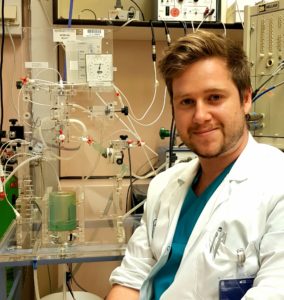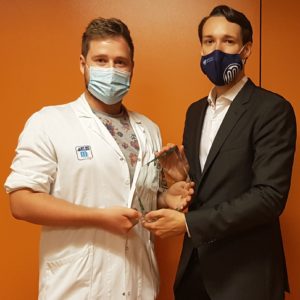

We are very delighted to present to you Patrick M. Pilz who has been selected as the PhD Student of the Month for June 2020. Patrick is enrolled in the N094 programme „Vascular Biology“ and his work at the Ludwig Boltzmann Cluster for Cardiovascular Research at MUV’s Center for Biomedical Research has already led to two publications as first author in peer-reviewed scientific journals. He will continue his research career at the Cardiovascular Institute of the Stanford University School of Medicine in California, USA, as he has received a Max Kade Scholarship from the Austrian Academy of Sciences.
In the translational research group led by Bruno Podesser and Attila Kiss, Patrick is investigating cardiovascular diseases and their underlying pathological changes in the myocardium and vessels, called cardiac/vascular remodeling, using different animal models. The research group evaluates various treatments such as drugs, surgical techniques, materials and the promising new therapeutic approach „remote ischemic conditioning“ (RIC), meaning short, non-lethal ischemic and reperfusion episodes on extremities during or after the ischemic event (myocardial infarction in this case). To investigate underlying pathologies or novel treatments and their impact on cardiovascular diseases, the group is using a variety of methods, e.g. the isolated heart apparatus (beating heart ex vivo mounted on a machine), myograph measurements (for vessel stiffness), in vivo catheter-measurements as well as histological, molecular/epigenetic and immunohistochemical analyses. Worldwide, cardiovascular disease and especially myocardial infarction are still the reason number one for morbidity and mortality. Thus, millions of patients around the world could benefit from the research in this field.
In his thesis project, Patrick clarified the effect of RIC on cardiac function after myocardial infarction in a rat model. Patrick and his colleagues demonstrated for the first time that the cardioprotective effects of RIC on adverse left ventricular remodeling are linked to epigenetic changes of Neuregulin-1 and subsequenly, its upregulation stimulates cardiac repair as well as remodeling and reduces scar expansion in the myocardium. The second important finding was that RIC improved cardiac contractility filaments‘ calcium sensitivity and reduced ACE activity in the infarcted myocardium. Both mechanisms contribute to a reduced risk of heart failure.
We wish Patrick all the best for his postdoc position at Stanford University!